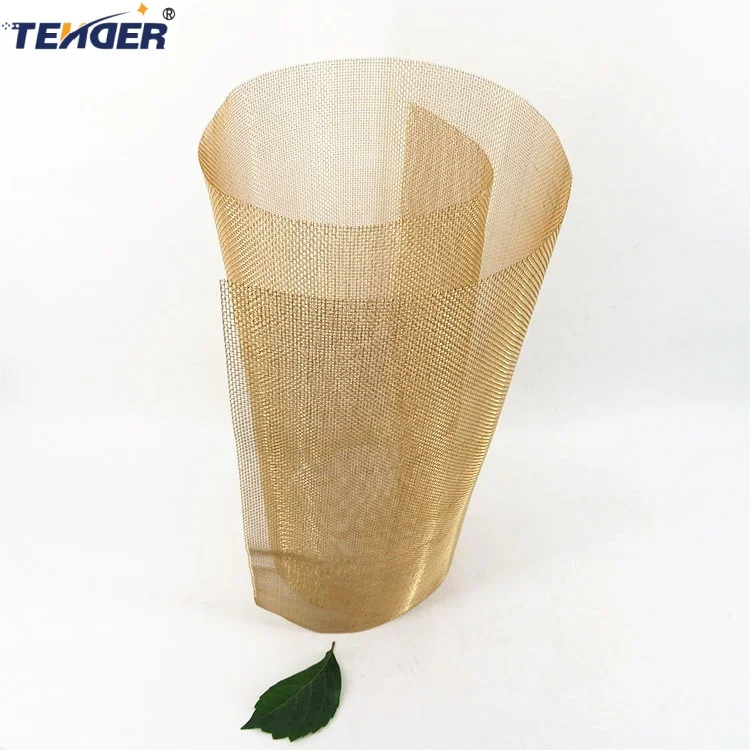If you work in filtration, screening, or papermaking, you’ve probably handled brass woven wire mesh more times than you can count. To be honest, I still like it for its balance of corrosion resistance, conductivity, and the way it just… behaves in the loom. Many customers say it “seats” better than plain steel. And yes, the papermaking folks still call it papermaking cloth—phosphor bronze in the warp, brass in the weft—because it lasts and cleans predictably.

What’s trending (and why buyers care)
Two things: traceable supply and tighter weave tolerances. OEMs in electronics and process filtration want ISO-backed consistency and test data tied to each roll. Also, demand for brass woven wire mesh with verified CuZn35 (≈65% Cu / 35% Zn) remains strong because it balances springiness and formability, and—surprisingly—handles mild acids/alkalis better than people remember.
Key specifications (real-world picks)
|
Parameter |
Typical Range |
Notes |
|
Alloy |
CuZn35 ≈ 65% Cu / 35% Zn |
Good formability; ≈28% IACS conductivity |
|
Mesh Count |
10–200 mesh |
ISO 9044 / ASTM E2016 tolerance |
|
Wire Diameter |
0.04–0.50 mm |
Annealed or hard-drawn, real-world use may vary |
|
Open Area |
15–70% (≈) |
Depends on mesh/diameter combo |
|
Weave Types |
Plain, Twill, Dutch |
Dutch for finer filtration |
|
Widths / Rolls |
0.9–1.5 m wide; 30 m rolls (≈) |
Custom slitting to ±0.5 mm |
Process flow and quality gates
Materials: certified CuZn35 rod → multi-stage wire drawing → intermediate anneal → precision winding. Methods: shuttle/rapier weaving (plain/twill/Dutch) → calendaring (if needed) → degrease/neutralize → slit → anti-tarnish pack. Testing: mesh count/warp-weft alignment per ISO 9044, dimensional per ASTM E2016, tensile on wire lots (ASTM B134/B135), conductivity spot checks, salt-spray (ASTM B117) for comparative tarnish. Service life: ≈2–5 years indoors; ≈6–18 months in splash-acid or coastal air (depends on pH and maintenance).
Where it’s used (and why)
· Papermaking cloth: phosphor bronze warp + brass weft for sheet stability and clean release.
· Process filtration: solvents, resins, and mild chemicals where brass woven wire mesh resists attack better than plain steel.
· EMI/RF shielding: moderate conductivity with easier forming than stainless.
· Architectural screens: warm color tone; honestly, designers just love the look.
· Sieving in labs and artisanal food production (with proper compliance check).
Vendor snapshot (what to watch)
|
Vendor Type |
Lead Time |
Certs |
QA/Traceability |
Price Band |
|
Mill-direct OEM |
2–4 weeks |
ISO 9001, RoHS/REACH |
Heat/lot maps, roll-level COAs |
Mid |
|
Regional distributor |
Stock–1 week |
Varies |
Basic COC; mixed lots |
Mid–High |
|
Offshore trader |
3–6 weeks |
Limited |
Spotty records |
Low |
Customization that actually matters
Common tweaks: slit-to-width strips for spiral-wound cartridges; twill weave for higher burst strength; annealed finish to prevent spring-back during forming; reinforced selvedges for wide web handling; oil-free cleaning for sensitive coatings. For woven brass mesh, specify target open area and edge condition upfront—it saves a lot of back-and-forth.
Mini case notes from the field
Specialty paper mill (EU): swapped to brass woven wire mesh weft with phosphor bronze warp; uptime improved ≈9% and sheet defects dropped after switching to Dutch weave in the wet section. Feedback was blunt: “It cleans easier—less varnish-like buildup.”
Electronics enclosure shop (US): moved from tinned steel to brass woven wire mesh for EMI vents. Result: faster forming, fewer burrs, and acceptable shielding after nickel plating. Lead time shrank by a week—big deal in their words.
Compliance, testing, and documentation
Typical deliverables: ISO 9001 QMS, RoHS/REACH statements, roll-level COA, mesh-count report (ISO 9044), dimensional check (ASTM E2016), and, when requested, ASTM B117 salt-spray comparative notes. Food-contact use depends on your process—ask for a targeted risk review.
Final thought: brass is having a quiet comeback. It’s not flashy, but in cost-per-run and formability, it keeps beating stainless in certain niches.
References
1. ASTM E2016 – Standard Specification for Industrial Woven Wire Cloth.
2. ISO 9044 – Industrial Woven Wire Cloth: Technical Requirements and Tests.
3. ASTM B134/B135 – Brass Wire Specifications.
4. ASTM B117 – Standard Practice for Operating Salt Spray (Fog) Apparatus.
5. RoHS (Directive 2011/65/EU) and REACH (EC 1907/2006) Compliance Guidance.
Anping Tengde Metal Wire Mesh Products Co., Ltd. Has been dedicated to the production and research and development of wire mesh products for 30 years. Leading Vibrating Screen It is a comprehensive department integrating production and processing, distribution and wholesale. Stainless steel mesh series, wire mesh products series, and filter elements and filter materials. Wire MeshWe can also produce various special-shaped net types and deep-processed net products according to customer needs and requirements. wire mesh suppliers All our products leaving the factory have undergone strict inspection to ensure that they are 100% qualified. Filtration Screens ManufacturerThe company adheres to the business philosophy of “technology leadership and quality victory”, and has nearly a hundred MID-to-senior level professional and technical personnel. wire mesh manufacturer We have maintained long-term and good cooperative relations with large domestic oil fields, coal mines, petroleum, machinery, chemical and other units, and have established good trade relations with more than 70 countries including the United States, Japan, Russia and Australia. Anping Tengde Metal Wire Mesh Products Co., Ltd.wire mesh screens suppliers Will continue to adhere to the tenet of “customer first, integrity-based”, and with the spirit of continuous innovation and win-win cooperation, forge ahead and challenge the future.wire mesh filter manufacturers|mesh wire suppliers